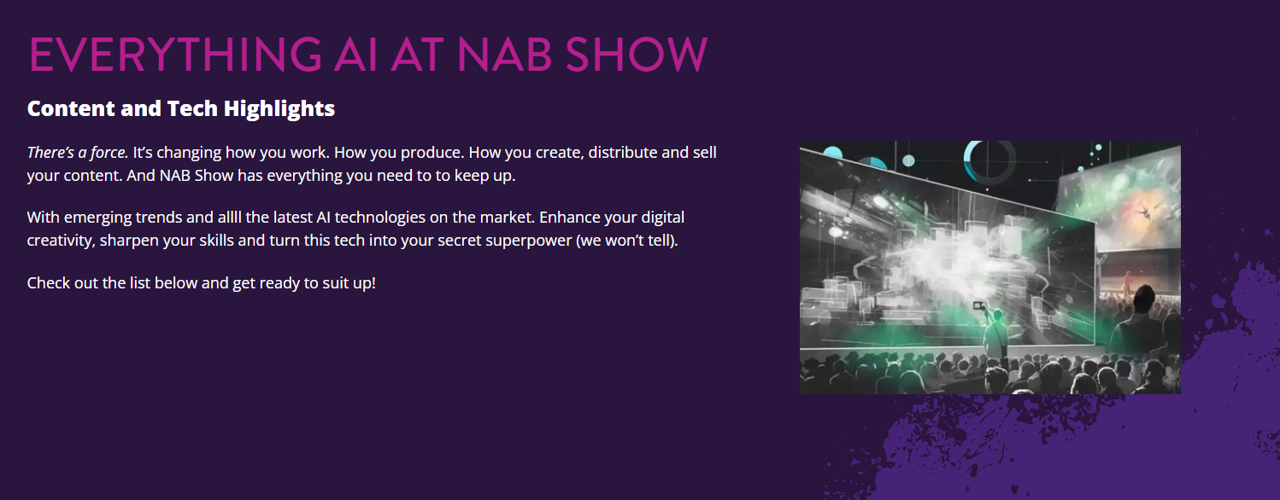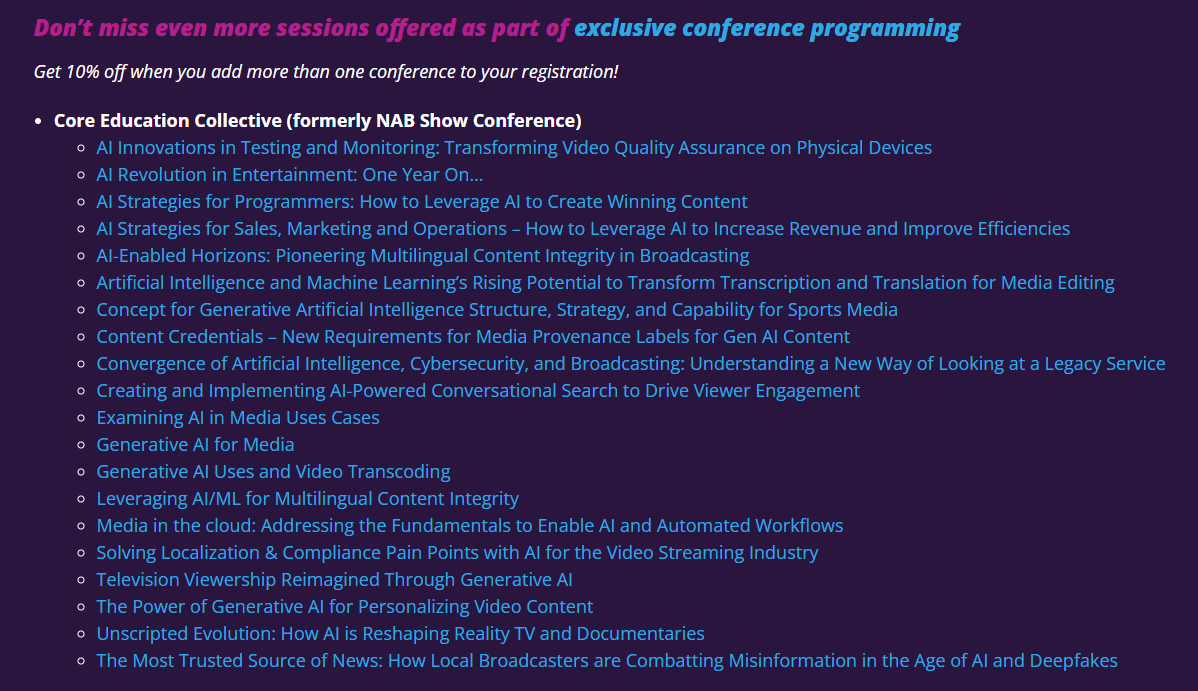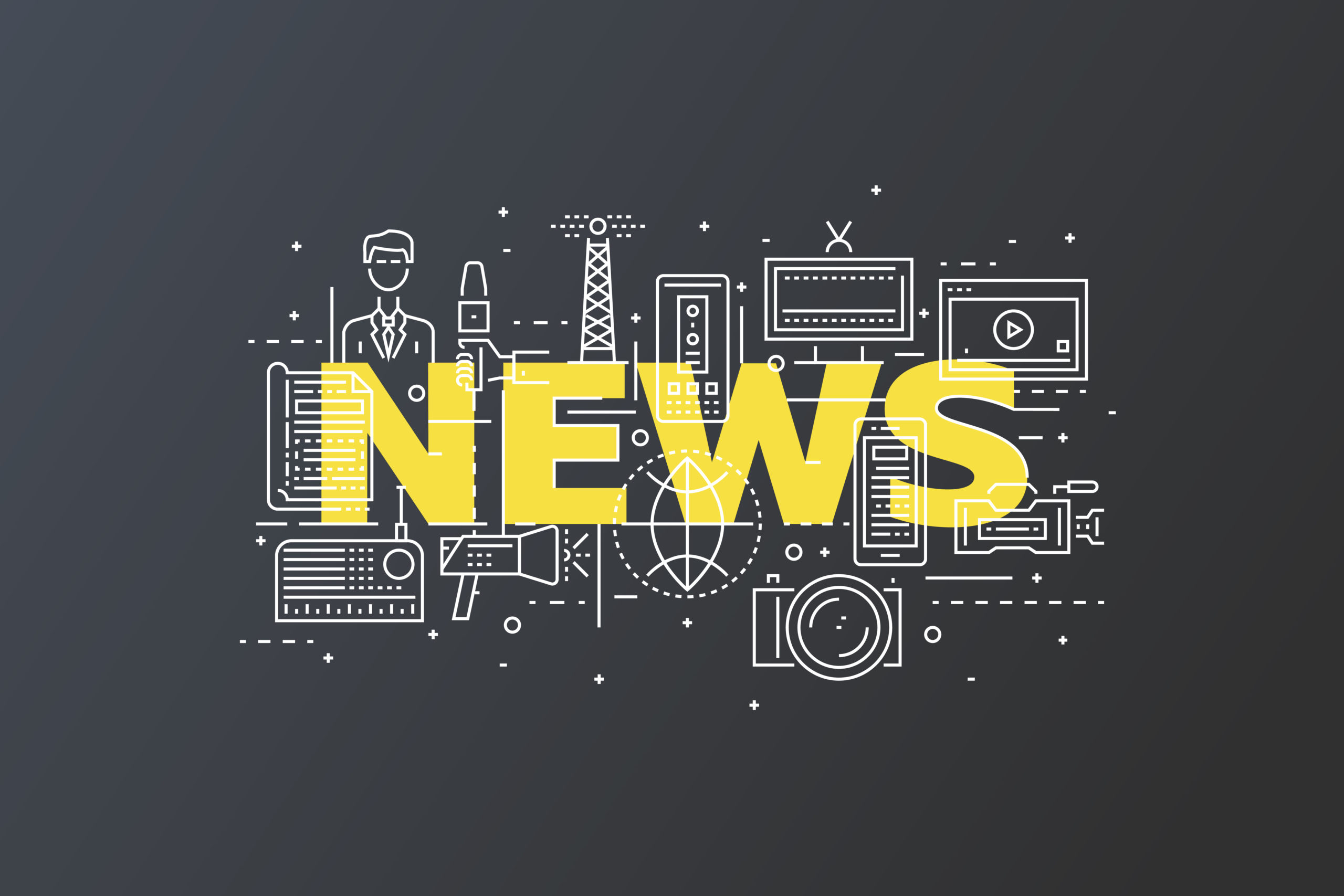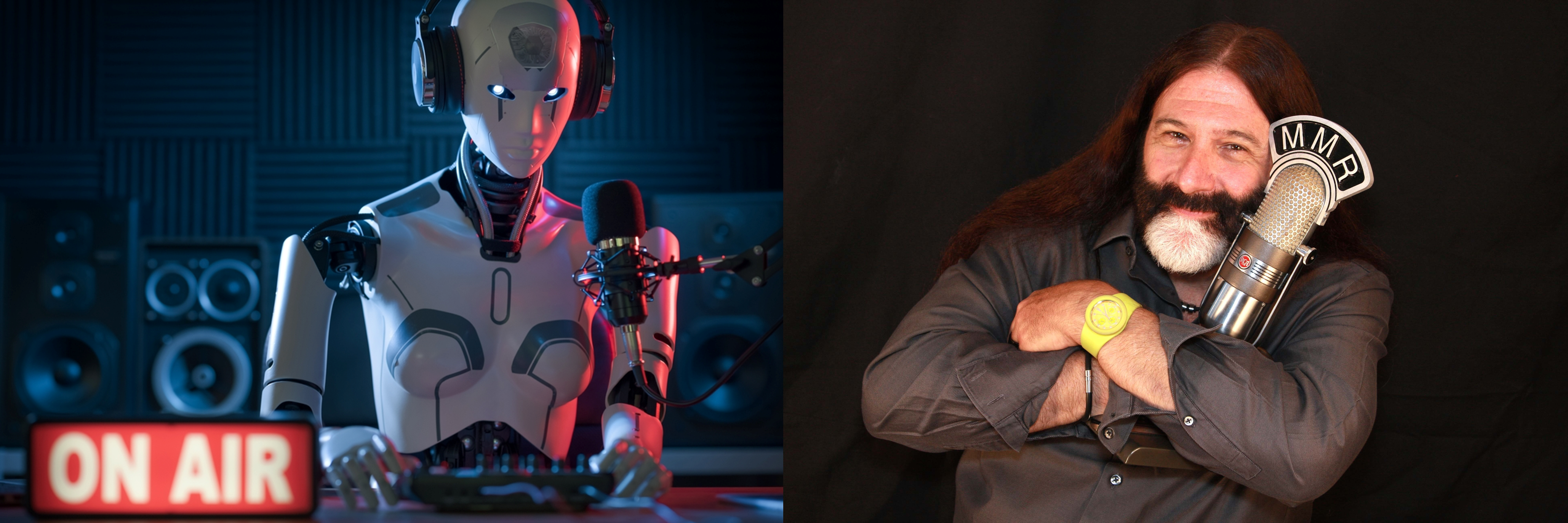
Dateline: The NAB in Las Vegas
The scene: The bar in both the Encore and Wynn (you can’t tell ’em apart) is teaming with radio’s C-suite executives, hangers-on, job seekers, and a lot of tourists wondering what the fuss is all about.
The big topic: AI, what else?
The NAB in its infinite wisdom was ready for this. There are panels, sessions, workshops, and even a red-headed young man talking to a robot. Here’s how the NAB framed their AI-heavy schedule:

I took the NAB’s advice. Of course, I brought a conservative suit (hey, it IS the NAB, right?), and following instructions, I donned it.
And then in an effort to hone my skills, enhance my digital creativity, and “turn this tech into (my) secret superpower,” I strategically scanned the schedule, looking for the perfect sessions to attend. And I immediately went into a panic attack – a full-on decision stress moment.
Given the choices, which ones would YOU have chosen?

That’s right – 20 sessions, along with two workshops requiring extra cash. And I honestly don’t know whether I’ve missed something.
For over a year now, AI is pretty much what we’ve talked about in the world of radio. Many support companies that have rolled out AI-inspired products to radio. Jacobs Media’s Chris Brunt started “AI Edge,” a newsletter – and a pretty damn good one – designed as a practical guide for radio people. (You can register for it here.)
But for the most part, AI strategies in radio have revolved around how companies – and more specifically, radio stations – can make effective, scalable use of AI. But that thinking overlooks a key strategic question:
What if your competition is coming after YOU with their AI innovation?

And that means as your station or company is implementing AI policies of your own, you need to be cognizant of the other players in the game and how they’re using this cutting-edge technology.
Not surprisingly, Axios is thinking along these lines. Regular JacoBLOG readers know I frequently take stock of what Axios is up to, because they are laser-focused on owning local market news. Their rollout continues, working their way across the U.S. And its founder and chief executive, Jim VandeHei (pictured) is thinking of his response to all the AI in his company’s midst.
You may recall Axios has been very active in pursuing a strong foundation in local news. They’re in roughly 30 markets with smart, incisive newsletters. You might also remember Axios was sold to Cox Enterprises – yes, they’re the ones who owned all those radio stations many of you worked for or competed against.
Axios’ media strategy is simple: own the local news turf. VandeHei is focused on understanding the changing ways in which people will discover and consume news in the not-so-distant future. And he believes AI innovation will leave a lot of media corpses in the dust.
As he explained recently to the New York Times’ Kate Robertson, AI will “eviscerate the weak, the ordinary, the unprepared in media.” Clearly, no words are being minced in VandeHei’s AI analysis.
Think about those implications through the radio news lens – especially given the tumult that’s been taking place in public radio. Meanwhile, the commercial radio companies with all those heritage all-news stations in many of the nation’s biggest markets is going through bankruptcy. Indeed, broadcast radio news is having “a moment.”
 So, what’s the answer? How can organizations like Axios, NPR, and legacy major market radio stations like WCBS, WWJ, and WBBM radio compete in this environment?
So, what’s the answer? How can organizations like Axios, NPR, and legacy major market radio stations like WCBS, WWJ, and WBBM radio compete in this environment?
Given what VandeHei refers to as “a very fundamental shift in how people relate to news and information, as profound, if not more profound, than moving from print to digital,” AI is rapidly careening toward a key inflection point. And if you’re in media, you’re either in the driver’s seat or you’re along for the ride.
So, how will radio play it? First, it would be smart to start thinking about AI from the competition’s point of view – not just our station’s plan for how to harness the technology. And secondly, form teams of insiders and outsiders who have a deep understanding of this technology to figure out the smartest AI offense and defense.
From there, VandeHei points to Axios’ new modus operandi for the AI tsunami to come. In fact, he predicts that in the next 5-10 years, we’ll be “living in this AI dominated world.”
His expectations? Once everything shakes out, maybe there will be a “couple of players in the media space offering smart, sane content who are thriving.”
As he concludes, “It damn well better be us.”
Of course, many radio operations are already competing in the same arena with VandeHei and Axios. Meantime, AI’s impact won’t be limited to news and spoken word programming. Music platforms liberally use AI tools in their effort to dominate the landscape.
So, what VandeHei’s plan?

- Invest in talent – The focus will be on exclusive reporting, events and networking revolving around a popular Axios journalist, Eleanor Hawkins (pictured). Her newsletter is free, but for those who sign up for a new $1,000/year membership program, they’ll be able to access additional news, data, and info, as well as participate in a quarterly chat with Hawkins. Similar membership programs will be built around top talent. To compete against AI, Axios is going with a personality approach.
- Develop specialized interest areas – Axios will double-down on content for key verticals for a subscription costing $599 each. We’re seeing that approach working for news consumers in public radio where listeners appreciate a focus on key coverage areas (e.g., climate, politics, women’s issues, etc.) anchored by a known journalist. Again, the lean is on personality as an AI antidote.
- Quality wins out – Perhaps this goes without saying, but VandeHei thinks the key to beating back AI news coverage is “having a superior product.”
This last point is how Axios visualizes its edge against new AI competition, no matter how it develops:
“The premium for people who can tell you things you do not know will only grow in importance, and no machine will do that.”
 Thinking about VandeHei’s strategy through the radio lens is sobering. For years, many broadcasters have checked off those digital boxes, whether we’re talking mobile apps, newsletters, podcasts, or websites. The emphasis has often been about coverage – not quality.
Thinking about VandeHei’s strategy through the radio lens is sobering. For years, many broadcasters have checked off those digital boxes, whether we’re talking mobile apps, newsletters, podcasts, or websites. The emphasis has often been about coverage – not quality.
Given how ubiquitous AI is becoming, everyone will be using the predictive, time-saving tools, so how will anyone stand out? AI that easily mimics so-so personalities isn’t a winning strategy. It simply evens up the playing field with a competent, but forgettable product.
VandeHei’s philosophy is that it will come down to quality content presented by magnetic, compelling, and knowledgeable people.
Isn’t that how many radio stations were actually built back in the day?
Back to the future…or there may not be one.
Meantime, I’m going to find an AI panel to attend.
- Is It Time For Radio to WAKE UP?! - June 1, 2025
- For Radio, The Perils Of Rebranding - May 30, 2025
- There’s No Failure In Radio - May 29, 2025




My suggestion:
Skip the AI sessions and go see Cirque Du Soleil’s “O” at the Bellagio.
Good call!
In many (if not most) cases, we can only focus in on one or two things. Listening to one-reading another. If AI can help find the biggest most compelling stories, they can be delivered by a human in a compelling way. We can’t be everywhere-but we can be more interesting with the HELP of Artificial Intelligence. It’s not the total answer but can be a great tool. A lot of companies are placing their future in artificial intelligence and it will be interesting to see who’s here in 10 years.
“To compete against AI, Axios is going with a personality approach.”
Especially in light of yesterday’s post (on stans), I think you can make the argument that “a personality approach” can work in both directions–i.e., that it would also be somewhat listener/community-based, in order to help build loyalty.
I’ve spent some time recently (for other purposes) with some larger Italian stations, and noticed that two of the ACs or CHRs (R101 and RDS) very conspicuously promote signups for their listener/music panels on their sites. (For R101, it was even the lead/primary item on their homepage yesterday.) While there are definitely U.S. counterparts (e.g., K-Love’s “Insider”), even those might not be as promoted as much.
On a completely separate note, I just saw this…
https://techcrunch.com/2024/04/16/amazon-music-follows-spotify-with-an-ai-playlist-generator-of-its-own-maestro
(Spotify’s effort isn’t being tested yet in the U.S.; Amazon’s, though, is starting out domestically.)